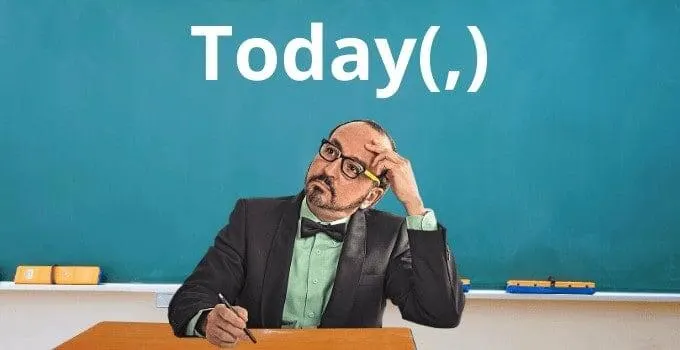Commas can be confusing for many. The rules aren’t always clear, and a lot of the times putting a comma becomes a matter of judgment.
It becomes a matter of whether a comma will enhance the meaning or improve the legibility of the text.
However, even when there are clear cut rules, these can be hard to discern.
For example, some words seem to require a comma at times, whereas, at other times, these same words are as far away from a comma as possible.
Take for instance a word like “today.” Sometimes, it is followed by a comma, and sometimes, it isn’t. Yet, in both cases, there are solid rules that need to be adhered to. So, what are they?
Is “today” followed by a comma?
If “today” comes at the beginning of a sentence and acts as an adverb, then a comma would be necessary. Alternatively, if it is in the middle of the sentence or is acting as a noun, then you don’t need to use a comma unless the overall sentence structure requires it.
”Today” as a noun
“Today” can be either a noun or an adverb. When functioning as a noun, “today” behaves like almost every other noun. It can be the subject of the sentence or the object of a verb. It can also be used as an appositive noun.
Example:
Today is a good day.
Here, “today” is the subject of the sentence.
This Tuesday, today, is a busy day for me.
In the second example, “today” is an appositive phrase that further specifies the preceding noun, which is “this Tuesday.” Even though this example is grammatically correct, it may come across to some of you as a bit pedantic.
After all, no one talks like this, which is why you won’t often see “today” used as an appositive noun.
Does “today” the noun take a comma?
The answer is no. There is no specific reason that “today” the noun should be followed by a comma. After all, it is just another noun.
However, like any other noun, when used as an appositive, it is surrounded by a comma on both sides. Yet, we also saw that this usage was fairly rare.
”Today” as an adverb
When it is an adverb, It helps specify the time a particular verb takes place.
Example:
I went for a walk today.
In the above sentence, “today” lets us know when I went for a walk.
With this in mind, “today” the adverb can be used in one of two ways. It can either come in the middle of the sentence or come at the beginning of a sentence as an introductory word.
Example:
Someone called you today after you had just left.
In this example, “today” is in the middle of the sentence.
Today, someone called you after you had just left.
This is the other usage where “today” comes at the beginning of a sentence as an introductory word.
Does “today” the adverb take a comma?
Well, it depends.
If “today” is in the middle or at the end of the sentence, then a comma is not needed.
Example:
We learned the multiplication table at school today.
We saw him today at the park.
However, if “today” comes at the beginning of the sentence as an introductory word, then it should be followed by a comma.
Example:
Today, we are going to finish our homework.
Today, we celebrate our Independence Day.
In fact, any introductory word that comes at the beginning of a sentence should be followed by a comma. Other introductory words you might be familiar with include “furthermore” and “suddenly.”
Also, other temporal expressions such as yesterday, tomorrow, in a few days, next month and so on, they all need to be followed by a comma when they come at the beginning of a sentence.
Example:
Furthermore, the countries would never agree to a peace treaty under these conditions.
Suddenly, a big, black dog jumped up from behind the bushes.

Hey fellow Linguaholics! It’s me, Marcel. I am the proud owner of linguaholic.com. Languages have always been my passion and I have studied Linguistics, Computational Linguistics and Sinology at the University of Zurich. It is my utmost pleasure to share with all of you guys what I know about languages and linguistics in general.


